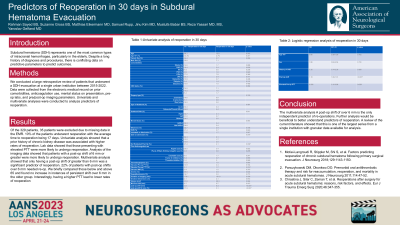Predictors of Reoperation in 30 days in Subdural Hematoma Evacuation
Predictors of Reoperation in 30 Days in Subdural Hematoma Evacuation
Friday, April 21, 2023


Rahman Sayed, BS
Medical Student
Albert Einstein College of Medicine
Morris Plains, New Jersey, United States
ePoster Presenter(s)
Introduction: Subdural hematoma (SDH) represents one of the most common types of intracranial hemorrhages, particularly in the elderly. Despite a long history of diagnoses and procedures, there is conflicting data on predictive parameters to predict outcomes.
Methods: We conducted a large retrospective review of patients that underwent a SDH evacuation at a single urban institution between 2015-2022. Data were collected from the electronic medical record on prior comorbidities, anticoagulation use, mental status on presentation, pre-op labs, and pre/post-op imaging parameters. Univariate and multivariate analyses were conducted to analyze predictors of reoperation.
Results: Of the 329 patients, 35 patients were excluded due to missing data in the EMR. 10% of the patients underwent reoperation with the average time to reoperation being 17 days. Univariate analysis showed that a prior history of chronic kidney disease was associated with higher rates of reoperation. Lab data showed that those presenting with elevated PTT were more likely to undergo reoperation. Analysis of the imaging data showed that patients with a post-op shift of 6 mm or greater were more likely to undergo reoperation. Multivariate analysis showed that only having a post-op shift of greater than 6 mm and an elevated pre-op PTT were significant predictors of reoperation. 22% of patients with post-op shifts over 6 mm needed re-op. We briefly compared those below and above 65 and found no increase instance of persistent shift over 6 mm in the older group
Conclusion : With the exception of elevated PTT, a persistent post-op shift of over 6 mm is the only independent predictor of re-operation. Further analysis would be beneficial to better understand this finding and other predictors of re-operation.
Methods: We conducted a large retrospective review of patients that underwent a SDH evacuation at a single urban institution between 2015-2022. Data were collected from the electronic medical record on prior comorbidities, anticoagulation use, mental status on presentation, pre-op labs, and pre/post-op imaging parameters. Univariate and multivariate analyses were conducted to analyze predictors of reoperation.
Results: Of the 329 patients, 35 patients were excluded due to missing data in the EMR. 10% of the patients underwent reoperation with the average time to reoperation being 17 days. Univariate analysis showed that a prior history of chronic kidney disease was associated with higher rates of reoperation. Lab data showed that those presenting with elevated PTT were more likely to undergo reoperation. Analysis of the imaging data showed that patients with a post-op shift of 6 mm or greater were more likely to undergo reoperation. Multivariate analysis showed that only having a post-op shift of greater than 6 mm and an elevated pre-op PTT were significant predictors of reoperation. 22% of patients with post-op shifts over 6 mm needed re-op. We briefly compared those below and above 65 and found no increase instance of persistent shift over 6 mm in the older group
Conclusion : With the exception of elevated PTT, a persistent post-op shift of over 6 mm is the only independent predictor of re-operation. Further analysis would be beneficial to better understand this finding and other predictors of re-operation.
